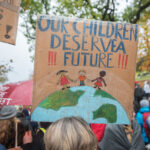
By Mattias Soderberg
One more year, and the climate crisis has become more severe. Scientists continue to raise the alarm, and more and more people and communities are suffering from the impact of global warming.
Looking back at 2021, we can all list a number of sad and frightening climate-related disasters. It is clear that that we have a climate crisis, not only in poor and vulnerable countries, but around the world. Tornadoes in the USA; flooding in Germany; drought in Madagascar and Afghanistan; and cyclones in the Pacific have all created headlines. For those affected – who have lost their loved ones, their houses and belongings, and have been forced to move – climate change is real. It is not just numbers on a chart, or paragraphs in an agreement. It is reality, one which has turned their lives upside down, and could affect all of us the same way.
While the list of climate disasters is long, the list of good news stories is short. However, we should hold on to these good news stories as they offer hope – hope that can be turned into action and hope that we can solve the climate crisis.
To begin with, I hold on to the fact that climate scientists still think it’s possible to limit the global temperature increase to 1.5 degrees. That is good news, because the same scientists have made it clear that a higher temperature increase may push the climate towards a number of tipping points that may jeopardize our future.
Secondly, the agreement from Glasgow’s COP26 climate summit includes a paragraph requesting all parties to revisit their national climate plans. These plans, also called NDCs (short for nationally determined contributions) tell us what parties want to do to tackle climate change. As the current level of ambition is too low, plans must not only be revisited, but also revised to increase their goals.
The COP26 agreement, as with many UN agreements, includes rather soft wording. There are few binding decisions and many encouraging suggestions. These provide loopholes that parties to the agreement may decide to use. For example, the EU has already declared that they don’t have to scale up their emission reduction ambition. They consider their NDCs to be ambitious enough. Unfortunately, that is an argument that all parties to COP26 can use, and the impact of the COP26 agreement is therefore in doubt.
Still, I choose to be optimistic in this final post of the year. I agree that it looks really worrying. There are few concrete signs of action to generate hope. But there are still useful options on the table, and I hope all parties will pick the right ones when they return to their offices after the Christmas and New Year’s break.
The climate crisis is real, not only for those who endured climate-related disasters in 2021, but for all of us. The climate crisis can be handled if we act now. We need bold action to reduce emissions and ensure a green transition in our communities. We need rapid and comprehensive initiatives to help us to adapt to the effects of climate change. And we must ensure that there is adequate support to help people and communities address climate-induced loss and damage.
I hope 2022 will become a turning point for the climate. Happy New Year.
Mattias Soderberg is Chief Advisor for DanChurchAid and co-chair of ACT’s climate justice working group.
